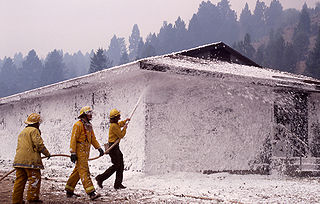
Marshmallow is a confectionery made from sugar, water and gelatin whipped to a solid-but-soft consistency. It is used as a filling in baking or molded into shapes and coated with corn starch. This sugar confection is inspired by a medicinal confection made from Althaea officinalis, the marsh-mallow plant.

A wetsuit is a garment worn to provide thermal protection while wet. It is usually made of foamed neoprene, and is worn by surfers, divers, windsurfers, canoeists, and others engaged in water sports and other activities in or on water. Its purpose is to provide thermal insulation and protection from abrasion, ultraviolet exposure, and stings from marine organisms. It also contributes extra buoyancy. The insulation properties of neoprene foam depend mainly on bubbles of gas enclosed within the material, which reduce its ability to conduct heat. The bubbles also give the wetsuit a low density, providing buoyancy in water.

Angel food cake, or angel cake, is a type of sponge cake made with egg whites, flour, and sugar. A whipping agent, such as cream of tartar, is commonly added. It differs from other cakes because it uses no butter. Its aerated texture comes from whipped egg white. Angel food cake originated in the United States and first became popular in the late 19th century. It gained its unique reputation along with its name due to its light and fluffy texture and white color.

Foams are materials formed by trapping pockets of gas in a liquid or solid.
Soap films are thin layers of liquid surrounded by air. For example, if two soap bubbles come into contact, they merge and a thin film is created in between. Thus, foams are composed of a network of films connected by Plateau borders. Soap films can be used as model systems for minimal surfaces, which are widely used in mathematics.

A soap bubble is an extremely thin film of soap or detergent and water enclosing air that forms a hollow sphere with an iridescent surface. Soap bubbles usually last for only a few seconds before bursting, either on their own or on contact with another object. They are often used for children's enjoyment, but they are also used in artistic performances. Assembling many bubbles results in foam.

A foam party is a social event at which participants dance to music on a dance floor covered in several feet of suds or bubbles, dispensed from a foam machine.

Glass microspheres are microscopic spheres of glass manufactured for a wide variety of uses in research, medicine, consumer goods and various industries. Glass microspheres are usually between 1 and 1000 micrometers in diameter, although the sizes can range from 100 nanometers to 5 millimeters in diameter. Hollow glass microspheres, sometimes termed microballoons or glass bubbles, have diameters ranging from 10 to 300 micrometers.

A bubble bath is a filled bathtub with a layer of soap bubbles on the surface of the water. Less commonly, aerated or carbonated baths are called bubble baths.
Air entrainment in concrete is the intentional creation of tiny air bubbles in a batch by adding an air entraining agent during mixing. A form of surfactant it allows bubbles of a desired size to form. These are created during concrete mixing, with most surviving to remain part of it when hardened.

Microfoam is finely textured milk used for making espresso-based coffee drinks, particularly those with latte art. It is typically made with the steam wand of an espresso machine, which pumps steam into a pitcher of milk.

Firefighting foam is a foam used for fire suppression. Its role is to cool the fire and to coat the fuel, preventing its contact with oxygen, thus achieving suppression of the combustion. Firefighting foam was invented by the Russian engineer and chemist Aleksandr Loran in 1902.
Super Elastic Bubble Plastic was the brand name for a children's toy manufactured from the 1970s through the 80s by Wham-O. It consisted of a tube of viscous plastic substance and a thin straw used to blow semi-solid bubbles. A pea-sized amount of liquid plastic was squeezed from the tube and made into a ball. One end of the straw was then inserted into the ball, and the user would blow into the other end, inflating the plastic into a bubble. The bubble could then be removed from the straw by pinching the hole closed, sealing the air inside.

A bubble is a globule of a gas substance in a liquid. In the opposite case, a globule of a liquid in a gas, is called a drop. Due to the Marangoni effect, bubbles may remain intact when they reach the surface of the immersive substance.
Underbalanced drilling, or UBD, is a procedure used to drill oil and gas wells where the pressure in the wellbore is kept lower than the static pressure of the formation being drilled. As the well is being drilled, formation fluid flows into the wellbore and up to the surface. This is the opposite of the usual situation, where the wellbore is kept at a pressure above the formation to prevent formation fluid entering the well. In such a conventional "overbalanced" well, the invasion of fluid is considered a kick, and if the well is not shut-in it can lead to a blowout, a dangerous situation. In underbalanced drilling, however, there is a "rotating head" at the surface - essentially a seal that diverts produced fluids to a separator while allowing the drill string to continue rotating.
Global Special Effects, formally known as Snowmasters Inc., is a special effects company headquartered in Lexington, Alabama. The firm, founded in 1992 by former magician Francisco Guerra, specializes in artificial snow, cryo, smoke, bubble and fog machines. The company's products have been used in music videos such as "Back to December" by Taylor Swift and "Mistletoe" by Justin Bieber, film productions such as Harry Potter and Lucky, television shows such as Fear Factor, and at Walt Disney Parks and Resorts.

Aerial advertising is a form of advertising that incorporates the use of flogos, manned aircraft, or drones to create, transport, or display, advertising media. The media can be static, such as a banner, logo, lighted sign or sponsorship branding. It can also be dynamic, such as animated lighted signage, skywriting, or audio.

Concrete is produced in a variety of compositions, finishes and performance characteristics to meet a wide range of needs.

Sea foam, ocean foam, beach foam, or spume is a type of foam created by the agitation of seawater, particularly when it contains higher concentrations of dissolved organic matter derived from sources such as the offshore breakdown of algal blooms. These compounds can act as surfactants or foaming agents. As the seawater is churned by breaking waves in the surf zone adjacent to the shore, the surfactants under these turbulent conditions trap air, forming persistent bubbles that stick to each other through surface tension.

Foam concrete, also known as Lightweight Cellular Concrete (LCC) and Low Density Cellular Concrete (LDCC), and by other names, is defined as a cement-based slurry, with a minimum of 20% foam entrained into the plastic mortar. As mostly no coarse aggregate is used for production of foam concrete the correct term would be called mortar instead of concrete; it may be called "foamed cement" as well. The density of foam concrete usually varies from 400 kg/m3 to 1600 kg/m3. The density is normally controlled by substituting all or part of the fine aggregate with the foam.















